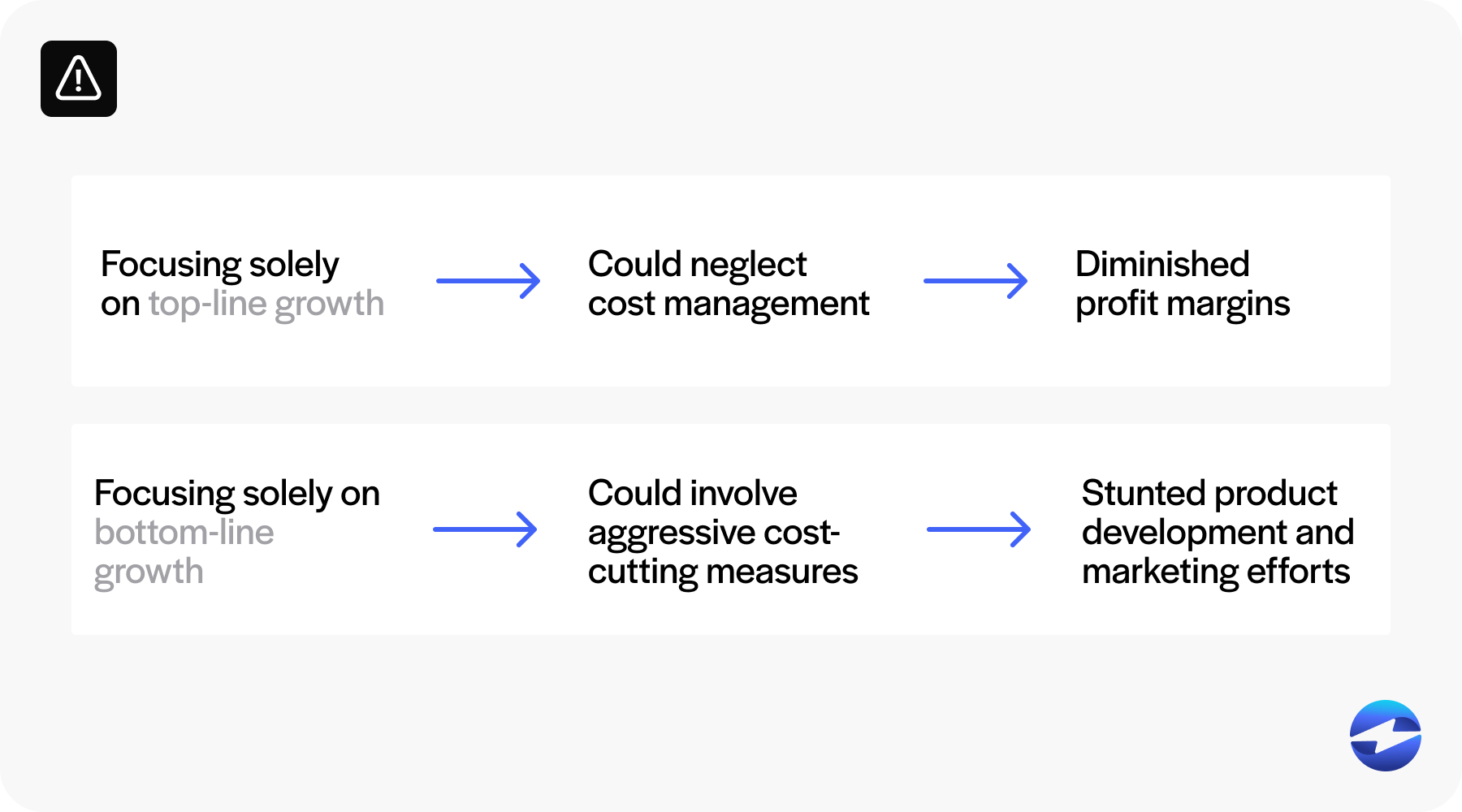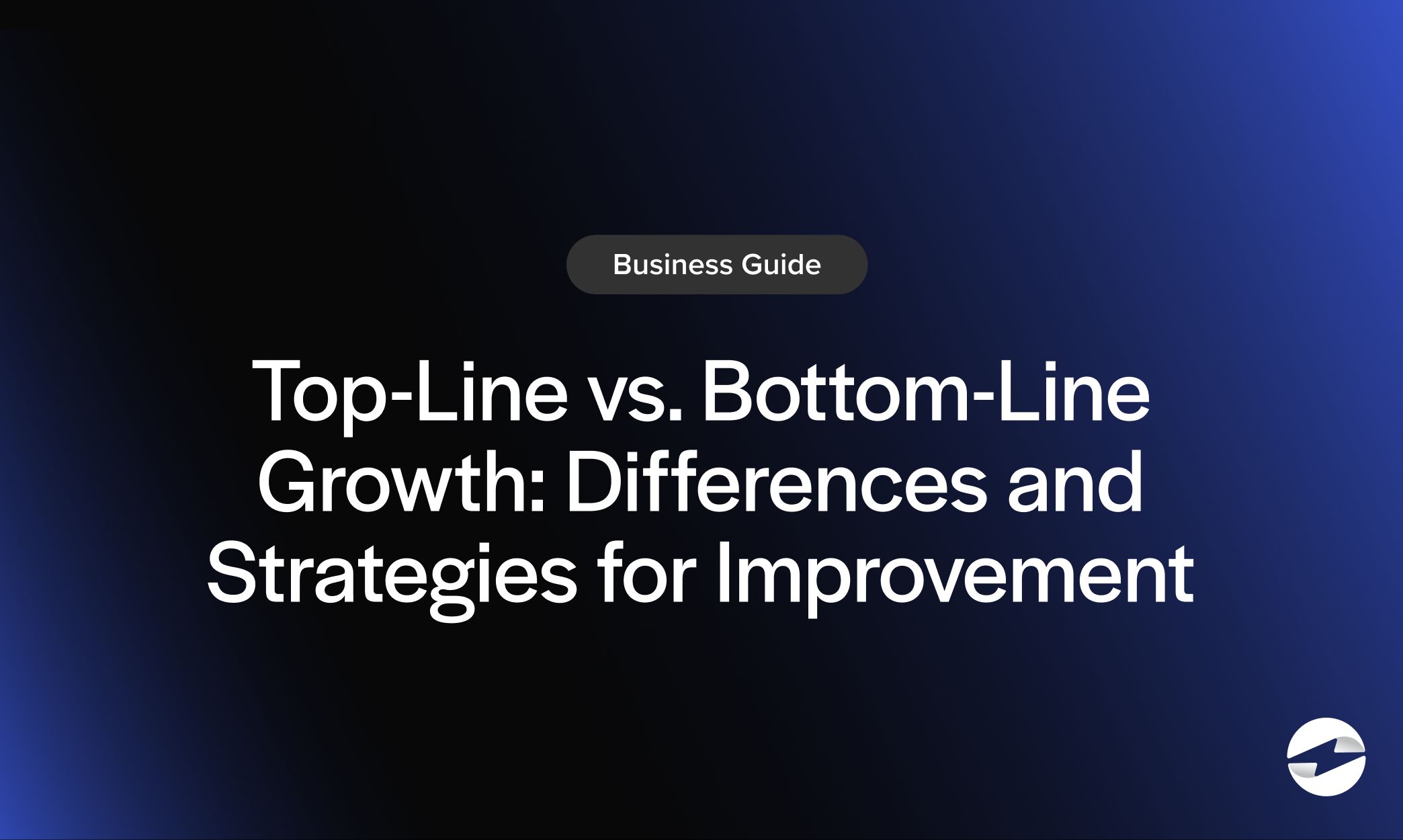Blog > Top-Line vs. Bottom-Line Growth: Differences and Strategies for Improvement
Top-Line vs. Bottom-Line Growth: Differences and Strategies for Improvement
Understanding the difference between top-line and bottom-line growth is vital for evaluating a company’s financial performance. To achieve sustainable growth, a company can balance efforts in both areas to unlock its full growth potential.
This article will explore the difference between top-line and bottom-line growth, the importance of balancing them, and strategies to find this balance.
Top-line vs. Bottom-line growth: What’s the difference?
Top-line and bottom-line growth refer to two distinct measures of a company’s financial performance. While both are critical indicators of success, they reflect different aspects of a business’s financial health.

What is top-line growth?
Top-line growth refers to the rise in a company’s total sales revenue or income. This metric reflects how well a company is increasing its market share, acquiring new customers, or expanding its product lines. It’s a critical indicator of business expansion and overall market presence, as captured on the income statement.
What is bottom-line growth?
Bottom-line growth, on the other hand, measures the increase in net income or profit, considering all expenses, taxes, and costs. This growth indicates how efficiently a company manages its operational and administrative expenses. Monitoring bottom-line growth offers insights into cost management and profitability, which is crucial for long-term financial sustainability.
While they represent different aspects of financial stability, it’s important to balance both top-line and bottom-line growth.
The importance of balancing both
Balancing top-line and bottom-line growth is crucial for sustainable financial performance.
Focusing solely on top-line growth might lead to higher sales but could neglect cost management, resulting in diminished profit margins. Conversely, prioritizing bottom-line growth could involve aggressive cost-cutting measures, potentially stunting product development and marketing efforts essential for revenue enhancement.

A balanced approach ensures that sales increases translate into profitability by optimizing revenue and expenses. This holistic strategy encourages robust product lines, efficient operations, and effective financial decisions, ultimately supporting sustainable growth.
By maintaining an equilibrium between increasing revenue and managing expenditures, companies can secure long-term growth potential while maximizing tax benefits and enhancing income statements. Understanding strategies for improving top-line and bottom-line growth is vital for any business aiming to boost sales revenue, market share, and profitability.
5 strategies for improving top-line growth
Effective strategies can increase sales, the cornerstone of top-line revenue, leading to sustainable growth and enhanced market positioning. Focusing on top-line growth helps companies identify new opportunities and align their resources to capitalize on them.
Enhance marketing and sales efforts: Enhanced marketing and sales efforts are crucial for boosting top-line growth. By tailoring marketing strategies to target specific customer segments and maximizing sales channels, businesses can increase their market reach and drive higher sales volumes. Investing in skillful sales teams and innovative advertising can significantly contribute to a noticeable rise in sales revenue.
Product and service innovation: Product and service innovation is key to improving top-line growth. Innovation attracts new customers and retains existing ones by offering unique and compelling value propositions. Developing or enhancing existing ones helps businesses differentiate themselves in the market, driving sales and expanding revenue streams.
Market expansion: Market expansion plays a significant role in boosting top-line growth. By entering new geographic territories or tapping into untapped customer segments, companies can increase their sales potential. Expanding market presence enables businesses to access a larger audience, contributing to increased sales revenue and enhanced brand recognition.
Improve customer retention: Improving customer retention is essential for sustaining top-line growth. Loyal customers not only contribute to consistent sales revenue but often make additional purchases and advocate for the brand. Implementing loyalty programs and enhancing customer service can solidify customer relationships, ensuring sustained revenue growth over time.
Strategic partnerships: Strategic partnerships can be a powerful driver of top-line growth. By collaborating with other organizations, businesses access new markets, share resources, and leverage mutual strengths. Partnerships can bolster sales efforts and introduce a wider array of products and services, significantly increasing sales revenue.

While it’s important to understand strategies for improving top-line growth, it’s equally important to understand strategies for improving bottom-line growth.
5 strategies for improving bottom-line growth
Understanding strategies for improving bottom-line growth is crucial for businesses aiming to enhance profitability. Efficient management and strategic financial planning can significantly enhance a company’s financial performance, leading to sustainable growth.
Cost optimization: Cost optimization involves reducing unnecessary expenses without compromising on quality. By analyzing operating costs such as raw materials, administrative expenses, and overhead expenses, businesses can identify areas for cost-cutting measures.
Increase operational efficiency: Increasing operational efficiency entails streamlining processes to maximize output while minimizing input. Enhancing productivity and reducing operational costs improve financial statements and overall financial performance. Implementing technology solutions and refining workflows can also lead to significant savings and a healthier bottom line.
Improve pricing strategies: Effective pricing strategies are essential for boosting bottom-line revenue. By analyzing market share and competition, businesses can adjust prices to maximize profits. A well-crafted pricing model considers consumer demand and production costs, ensuring that sales revenue contributes positively to net income.
Manage debt and financing costs: Managing debt and financing costs is vital for maintaining a healthy bottom line. Companies should evaluate their financial decisions to reduce interest expenses and leverage debt effectively. Refinancing high-interest loans and employing debt management strategies can lead to significant savings and improve overall financial stability.
Tax and financial planning: Tax and financial planning can greatly impact bottom-line growth. By strategically claiming tax benefits and deductions, businesses can lower their tax liabilities. Financial planning involves optimizing investment strategies and managing liquidity, thus improving the income statement and promoting long-term profitability.
These strategies will help improve bottom-line growth, leading to more sustainable growth. To balance both, look to top-rated payment solutions like EBizCharge, which can streamline payment operations.
Enhancing top-line and bottom-line growth with EBizCharge
EBizCharge significantly enhances both top-line and bottom-line growth for businesses by streamlining payment processing, facilitating quicker and more efficient sales transactions. This directly contributes to an increase in revenue and supports top-line growth. The platform’s seamless integration with existing accounting systems also boosts sales volume by offering customers more convenient payment options, thereby driving sustainable sales growth.
For bottom-line growth, EBizCharge reduces operating costs by minimizing processing fees and improving cash flow management. This not only decreases overhead and administrative expenses but also enhances operational efficiency. Additionally, the platform’s robust security features, including 3D Secure and TLS 1.2 protocols, reduce the risk of fraud, further safeguarding profits and maintaining healthy profit margins. By leveraging EBizCharge, businesses can strategically enhance both financial performance and growth potential.
 EBizCharge is proven to help businesses collect customer payments 3X faster than average.
EBizCharge is proven to help businesses collect customer payments 3X faster than average. 
